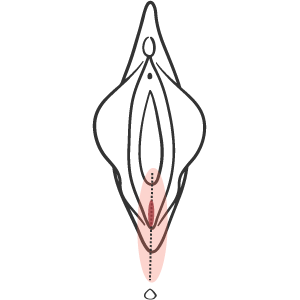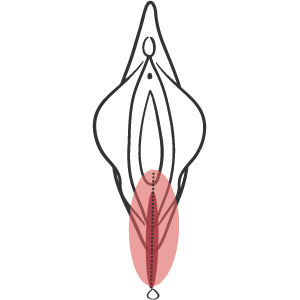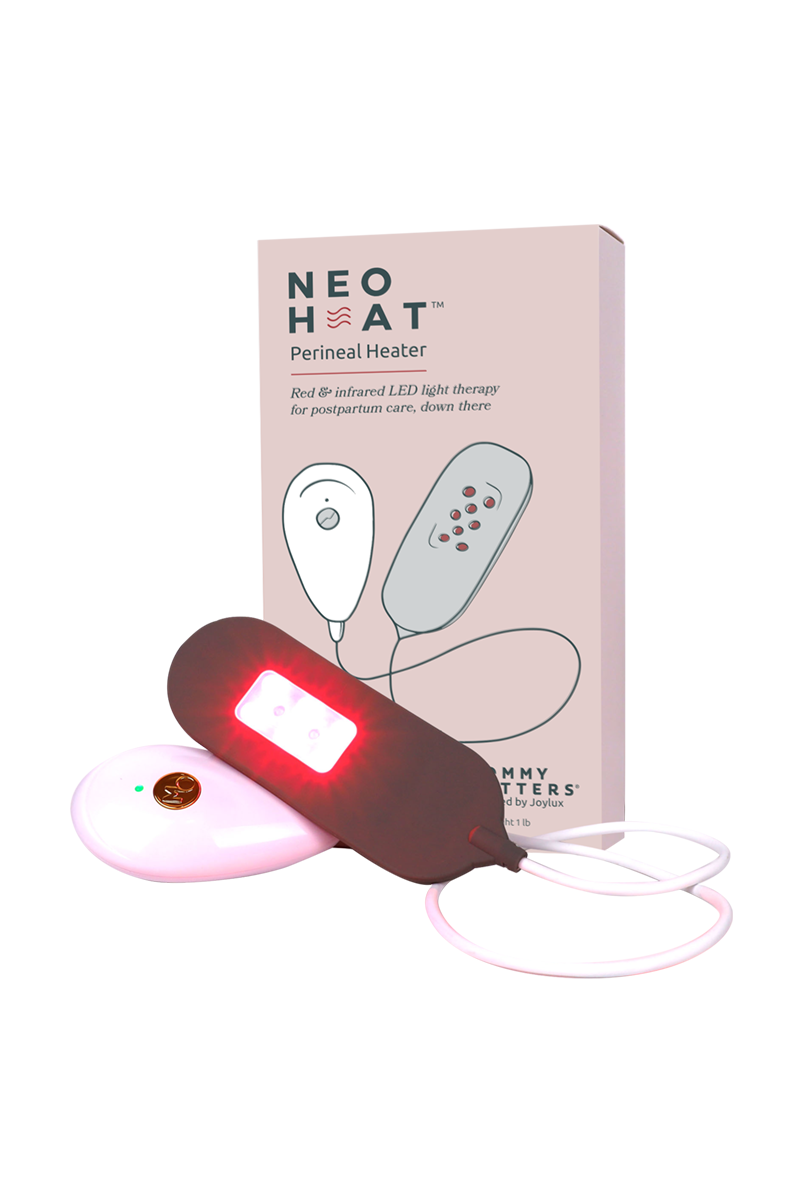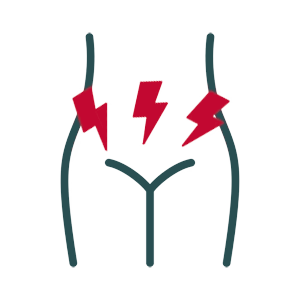Vaginal Childbirth 101
First, a quick refresh on the female anatomy:

Now, a general overview of what happens during vaginal childbirth:
The delivery process typically begins with the onset of labor, marked by regular contractions that gradually increase in frequency, duration, and intensity. As the contractions become more intense, the cervix (the opening to the uterus) gradually dilates (opens) to allow the baby to pass through.
Once the cervix is fully dilated at 10 cm, mama is ready to begin pushing. With each contraction, she pushes until the baby’s head is starting to emerge from the vagina (crowning) and then the healthcare provider guides the baby's head through the birth canal. Once baby's head is delivered, the provider will clear the baby's airways. Next, the provider will guide the baby's shoulders and body out of the birth canal, and baby is born.
The provider (and sometimes the partner) will clamp and cut the umbilical cord and place baby on mama's chest for skin-to-skin contact. The mother will continue to have contractions after the baby is born as her uterus works to expel the placenta (afterbirth).
This is birth in the simplest terms. Of course there are many variations to the process, and we know that everyone’s journey is different. We also know that 8 out of 10 vaginal deliveries result in mama experiencing some degree of tearing(1).
The Facts About Tearing & Episiotomies During Vaginal Birth
What is tearing?
Vaginal tearing is a very common occurrence during childbirth and impacts about 80% of women(1). It happens when the vaginal tissues and muscles stretch to accommodate the baby's head during delivery, causing damage to the perineum. There are four degrees of tearing, ranging from first-degree to fourth degree, with fourth degree being the most severe. Most women who tear experience second-degree tears(2).

First-degree tears are the least severe type of tearing, involving either or both a small superficial vaginal and perineal tear. It occurs between the vaginal opening and the rectum, and the tissue directly beneath the skin. These tears may heal on their own but can still cause pain and future issues.

Second-degree tears involve the vaginal tissues surrounding the vaginal opening and muscles of the perineum and might extend deep into the tissue impacting the nerves and can cause pain and discomfort during the healing process. Stitches are used to repair the tear and help it heal properly.

Third-degree tears extend from the vaginal opening into the muscle and nerves that surrounds the anus (anal sphincter). This type of tear can be very painful and require stitches to repair. Women who experience third-degree tears are also at risk of developing anal incontinence.

Fourth-degree tears are the most severe type of tearing-- extending from the vaginal opening, through the perineum to the anal sphincter and into the mucous membrane that lines the rectum (rectal mucosa) and the nerves. This type of tear requires stitches in multiple layers, prolonged healing time and can cause significant future issues.
What is an episiotomy?
An episiotomy is a surgical procedure in which a doctor or midwife makes a small incision in the perineum during the end of the second stage of labor, as the baby is being born. The purpose of an episiotomy is to widen the vaginal opening and facilitate the delivery of the baby. An incision might be recommended if a baby needs to be quickly delivered because:
- The baby's shoulder is stuck behind the pelvic bone
- The baby has an unusual heart rate pattern during delivery
- Forceps or vacuum extraction is needed during a vaginal delivery

There are two types of episiotomy incisions:
- Midline incision. A midline incision is done vertically. A midline incision is easier to repair. But it has a higher risk of extending into the anal area.
- Mediolateral incision. A mediolateral incision is done at an angle. A mediolateral incision is less likely to result in an extended tear into the anal area. However, this incision is often more painful and more difficult to repair.
How to Help Minimize Perineal/Vaginal Trauma
Wanting to prevent tearing or the need for an episiotomy during childbirth is a common concern for many women. There are several ways to reduce the risk of tearing, including:

Controlled pushing: Pushing too hard during delivery can increase the risk of tearing. Controlled pushing, where the mother pushes slowly and steadily, can help reduce the risk of tearing.

Perineal massage: This is a technique that involves massaging the perineum to help it stretch and become more flexible. Perineal massage can be done during pregnancy and has been shown to reduce the risk of tearing during childbirth.
Treating Perineal/ Vaginal Trauma

NeoHeat Perineal Healing Device
Tissue trauma due to childbirth is the reason we created NeoHeat. Prior options only masked the symptoms while your body tried to slowly heal on its own. Even with natural healing, there is often long-term damage with the nerves, tissue and muscles that is irreversible without treatment. Many women report their bodies are never the same after birth. These long-term risks can be loss of sensation, vaginal laxity, pain with sex and bladder leakage/incontinence. NeoHeat’s revolutionary technology uses the power of red and infrared light and gentle heat to accelerate the healing of the internal and external tissues and nerve damage, increase blood circulation, reduce inflammation and provide rapid pain relief, while also reducing the risk of long-term issues that can result from improper healing.
For topical soothing of the pain, we recommend our Soothe Perineal Spray . It is an all-natural blend of witch hazel, rose water, lavender & peppermint that provides cooling relief from stitches and swelling. Use as often as needed.
Long-term Risks Associated with Vaginal Births
If not healed properly, episiotomies/tearing can lead to long-term problems (3) including:

Urinary incontinence
Women who experience tearing during childbirth are at increased risk of developing urinary incontinence, which is the inability to control urine.

Fecal incontinence
Women who experience third or fourth-degree tears are at increased risk of developing fecal incontinence, which is the inability to control bowel movements.

Sexual dysfunction
Tearing during childbirth can cause pain and discomfort during sex, which can lead to sexual dysfunction.

Vaginal laxity
This is a sensation of vaginal looseness which may develop after pregnancy and vaginal delivery. Your vaginal tissues stretch beyond their ability to bounce back. For women who’ve delivered a large child or for women who’ve delivered several children vaginally, the risks for vaginal laxity heighten. As well, if instruments were used to aid in the delivery, such as forceps, you may end up with some degree of vaginal laxity.

Nerve damage
Compression of the peripheral nerves is the most common type of postpartum nerve injury. These nerve compressions can happen during labor, vaginal delivery. Symptoms may include, but are not limited to, lower extremity pain, weakness, numbness, or bowel and bladder dysfunction.
Helpful Tips
- Be prepared – purchase a NeoHeat before your delivery and take it with you to the hospital so that you can begin treatments right away.
- Keep our Soothe Perineal Spray in the fridge to provide relief from pain and wear our Postpartum Panty with the frozen cold pack.
References:
- National Library of Medicine: Risk factors for perineal and vaginal tears in primiparous women – the prospective POPRACT-cohort study
- ACOG Practice Bulletin - Clinical Management Guidelines for Obstetrician–Gynecologists
- National Library of Medicine: Long- and short-term complications of episiotomy
